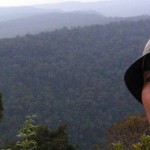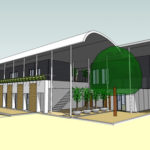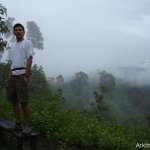Misty Rainforest Vibes
In front of me the river is making it’s way over a small waterfall and behind me I can hear the girls carrying on in the kitchen as they prepare lunch. I am sitting next to a 1:50,000 scale relief model of the Maliau Basin Conservation area which is to be my home environment for the next three months. Home itself is an accretion of zinc roofed shelters that meander across folds in the ground between leggy rainforest trees. As a white man and therefore head and shoulders taller than most Malaysians, I have to continually watch my head on forehead cracking beams. I also have to watch where my feet or chair legs are placed on the constantly varying floor levels. It is easily possible to push your chair back upon finishing your meal only to loose the back legs over an edge with hilarious consequences.
One of my jobs is to recommend improvements to this camp, named Agathis Camp after the concentration of huge Agathis trees in the area. It is required to cater for up to forty guests, most of whom visit Maliau to see the many waterfalls and unique geology and biodiversity of the basin. The camp’s strength is it’s connection to nature. From where I am sitting I can almost reach out and touch the rainforest and in fact nature itself is trying to crawl into the LAN port on my laptop as I type.
Most of my projects are camps similar to this. The conservation area managers want to expand the tourist potential of rainforest trekking by developing overnight camps on the trail network. On my previous visit here I checked out two such sites by helicopter; Lobah Camp and Seraya Camp. Exciting as this was it was nothing compared to trekking there on foot. What you miss out on with helicopter travel is the feeling of isolation and disconnection from normal life. You do get some sense of scale but this is distorted. 60m trees could easily be broccoli heads, With a little imagination. From the ground you rarely see the broccoli, in fact you’re lucky to even see the sky. It’s just tree trunks, lots of them and an awarness there is something big above you and around you. This closeness means that when you do get a view, it’s extra special.
There was a storm last night at Lobah Camp. Just before sunset I popped up to the clearing on the ridge that is used as a helicopter landing site. From that vantage point I could see clouds and rain advancing across the rim of the basin and down the valley towards us. At 1.00am I awoke with a start as thunder crashed directly overhead. I lay awake terrified that a stricken tree would demolish our camp, but there was nothing save the hammering of rain on corrugated zinc. Despite the roof and tarpaulin walls around me a fine spray of moisture settled on my face and dampened my sleeping bag. During a lull I ventured outside for a piss. In the darkness I imagined the forest spirits going about their business, tapping on my bare shoulders with cool drops of water. I switched my headtorch off and between flashes of lightning I could see no distinction between forest and sky. As my eyes adjusted to the dark, lights came on around my feet. Dappled phosphorescence seemed to float just above where the ground should be, the entire forest floor brightly mapped by a blanket of glow-in-the-dark fungus living off the leaf mould.
The rain stopped at about 7.00am shortly after sunrise. I rushed back up to the helicopter landing site to be rewarded with a view of crowns of emergent trees poking through the mist and the thunder of waterfalls hidden 500m below me. One of my jobs is to design a camp here. By selecting a few trees to chop down I’m hoping to open up this view to residents eating their fried rice breakfast on a veranda perched on the edge. The idea of chopping down a few trees is one that I’m relatively comfortable with now. I still feel the need to say sorry to the tree but I hope they’ll understand. The problem that I’m wrestling with on this trip is that my brief includes spattering the trails with pondoks and building gazebos at every waterfall and point du view.
A pondok here is usually a square pyramid roof on four posts with a bench or two underneath. They’re designed as a dry rest point for footsore trekkers. Problem is that after a year or two the roof is dented by falling branches, the timbers are decorated with graffiti and litter is trodden into the mud underfoot. This is in addition to the fact that I believe that people would want to walk these trails for the wilderness jungle ‘lost world’ vibe, which is incompatible with a pondok every hour. And don’t get me started on gazebos, even the word sounds awful!
My plan then is to try to sell a principle of restricting buildings to the camp sites and providing the ‘lost world’ vibe with views from the camps and either on the trails between camps or on loop walks to waterfalls. They’ve asked for my advice on trail construction too so hopefully we can avoid miles of ruler straight boardwalks but I don’t think there’s a way round the aluminium ladders that are necessary on many sections, particularly on approach to waterfalls. I’ve also got some bridges to design. I’ve never designed a bridge in my puff, unless you count that balsa wood contraption in first year Structures.
I’m not entirely sure how I’m going to get all this work done because office facilities are a little makeshift. I was hoping to stay at the new Maliau Basin Studies Centre but that is still under construction and out of bounds due to a recent malaria outbreak amongst the construction workers. Unfortunately, using the studies centre is unavoidable because that’s where the satellite internet connection is. Using it only by day when mosquitoes are asleep seems a good way around the problem, but getting there from Agathis Camp is a forty minute drive by battered Toyota landcruiser. The track is far from straightforward. On my last trip there we broke the rear drive shaft and had to radio for another battered landcruiser to tow us home.
Just in case you were worried that I’ll feel a little lonely in the jungle, the last four evenings I have been enjoying the company of Glen Reynolds, Senior Scientist at Danum Valley Field Centre, Charles Godfray, Professor of Zoology at Imperial College and Sir Peter Crane, Director of the Royal Botanical Gardens at Kew. I hope my after dinner banter is up to such intellectual company! I’m expecting them back from their animal spotting by searchlight ‘night drive’ shortly and am holding out that they will need my help to finish their bottle of cask strength Aberlour single malt.

Related Posts








Great site which I’ve just discovered after meeting Ian in BRL, Danum Valley. Brings back fond memories of Maliau which I visited last week. Shame it was so hazy when we were there. Hmmm, the bit about falling trees also brings back memories as we had the same thing at Lobah Camp…. everyone was lying in their bed listening to the tree falling in slow motion and wondering where the tree would land, and should we run out or await our fate.
I’ll be back to visit this site and eagerly await the updates……